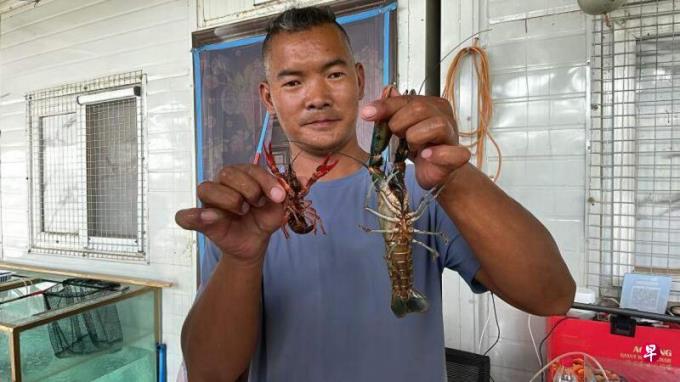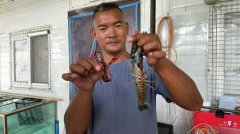
Xinjiang seafood has recently been on the Internet in China.
Since last week, the topic of seafood produced in Xinjiang has been reported by many Chinese media such as the People's Daily and Xinhua News Agency.On Weibo, there are no less than 10 related topics, including "no jokes of Xinjiang really produce seafood", "Xinjiang welcomes everyone to eat seafood", "How to do new seafood production" and so on.
In the outside world, Xinjiang, which has the vast desert, is rich in fruits such as grapes, cantaloupe, and has never thought that there are seafood in Xinjiang.It can't help but be curious. As the farthest inland province in China, what condition does Xinjiang have to produce seafood?
How does Xinjiang without the sea produce seafood?
The People's Daily reported on Monday (September 11) that the reason why Xinjiang can produce seafood is inseparable from the "seafood land care" model.It is reported that this model refers to creating an ecological environment similar to the ocean in land, and there are many ways to create such an environment, including turning saline water into "artificial seawater".This will start from the saline -alkali land in Xinjiang.
saline -alkali land refers to land with excessive salt and alkaline substances in the soil.In addition to the growth of a few salt -resistant plants, saline -alkali land is basically "no grass".
According to the articles on Friday (September 8th) of the media "Positive Solution", about one -third of Xinjiang's arable land has different degrees of saline alkali.However, Xinjiang is part of the ancient China Sea, and the water quality of saline -alkali land is very close to the seawater.Therefore, as long as the proportion of seawater minerals is used as a reference, and trace elements and probiotics are added, the saline -alkali land that ordinary animals and plants cannot survive can be turned into an environment for breeding seafood.
The WeChat public account of the financial communication service agency "Huashang Tao Lue" issued a statement on Sunday (September 10) that the No. 1 CPC Central Committee of the Communist Party of China in 2017 proposed "Promoting the Portable Pyramidation and Low -lying saline -alkali land",The "first shot" of saline -alkali land raised seafood.
In the same year, the Ministry of Agriculture and Rural Agriculture of China (formerly known as the Ministry of Agriculture) also released the 2017 fishery poverty alleviation and aid aid aid action plan for Tibet, requiring the promotion of "comprehensive development and utilization of saline -alkali land and farmers";Several opinions of the green development of the aquaculture industry, clearly proposed "actively developing saline -alkali aquaculture."
Huashang Tao strategically pointed out that with the leading and supporting national policy, Xinjiang has since set off a climax of "artificial sea".
On the other hand, Xinjiang's high -quality and rich water sources also play an important role.Xinjiang has the longest inland river Tarim River in China, the only Erzis River in China, which is injected into the Arctic Ocean.Under such geographical conditions, although the desert area of Xinjiang has reached 430,000 square kilometers, and the area of pasture is more than 510,000 square kilometers, the area of the waters still reach 5,500 square kilometers.
Xinhua News Agency quoted Deng Kang, director of the Fisheries Supervision Division of the Xinjiang Agricultural and Rural Department, said: "One of the main sources of water in Xinjiang is ice and snow melting water, the water quality is clear, the temperature is low, which is very suitable for the breeding of cold water fish."
Taking the salmon mentioned many times mentioned in media reports as an example, according to the Beijing News, in the Salmon Fish Base in Karasu Township, Nillaki County, Ili Kazakh, Ili, Ili,This year will achieve the goal of 6,000 tons of mass production.
In addition to salmon, Xinjiang also produced various seafood such as Australian freshwater lobster, South White Plack Shrimp, Crab, Siberian catfish, and golden catfish by diluting other modern technology methods.
According to the People's Daily, since 2022, the Xinjiang Production and Construction Corps set up 11 million yuan (RMB, Same, Same, about S $ 2.05 million) each year for the support to support the development of saline -alkali water fisheries in southern XinjiangEssenceAt present, the Agricultural and Rural Bureau of the Corps is preparing the military -alkaline water fisheries breeding plan for the Corps to vigorously promote the development of saline -alkali water fisheries in southern Xinjiang.
Urumqi Evening News reported in 2018 that in the 1950s, Xinjiang fisheries were mainly fishing, and the aquaculture industry was blank.In the 1960s, the local aquaculture industry began.Xinhua News Agency also issued an article in Xinjiang to say goodbye to "eating fish difficult", and mentioned that in the past, Xinjiang residents "most of them were transported from other places, and many farmers and herdsmen in remote areas did not even eat fish for a lifetime."
Xinjiang seafood popularity is related to Japanese nuclear wastewater?
Some opinions believe that Xinjiang seafood has recently become a hot topic, a great reason for the Japanese nuclear wastewater discharge of sea.
Japan has discharged to the ocean from August 24th to the destroyed radioactive wastewater from the destroyed Fukushima nuclear power plant.Some experts say that these wastewater will not now, and in the future, they will not endanger the health of those who eat seafood.But obviously not everyone believes in this statement, especially the Chinese people who have always had complex complexes for Japan.
On the day of Japan's official launch of the Fukushima nuclear waste water, China announced that it has comprehensively suspended the imported place of imports as Japanese aquatic products.Prior to this, China had banned the imports of 10 county aquatic products in Japan.
According to statistics, there are about 70,000 Japanese -style restaurants in mainland China, which are mainly concentrated in first -tier cities and coastal cities.With the introduction of the above ban, where these Japanese -style restaurants are going on is a big problem.Therefore, it is not difficult to understand why Xinjiang seafood will cause public and media discussions at this time.
Some netizens said that this can not only send it to the Chinese enterprises that rely on Japanese aquatic products, "the country has methods and the ability to fill the vacancy of the market."Consumers buy.
However, some netizens are not optimistic about Xinjiang seafood, and pointed out: "Xinjiang seafood production is doubled and less than 1%of the national output.The belly of 1.4 billion people is still far worse! "
According to local department statistics, in 2022, Xinjiang's annual aquatic product output was 173,000 tons, an increase of 1.4%over the previous year.Among them, the output of farming aquaculture products was 159,500 tons, an increase of 2.9%year -on -year.
Xinhua News Agency reported in May last year that the total output of Chinese aquatic products increased from 13.33 million tons in 1989 to 65.49 million tons in 2020, with an average annual growth rate of 5.27%; per capita aquatic product share from 11.82The kilogram increased to 46.38 kg, with an average annual growth rate of 4.51%.China is one of the largest aquatic products in the world.
and Wind Information (Wind) data shows that the number of imported aquatic products in China in 2022 was 4.53 million tons, and Japan ranked ninth in China's aquatic imported middle school, accounting for only 2.9 %, which is 13.1 13.110,000 tons.
In general, the current output of aquatic products in Xinjiang is still a large distance from coastal provinces such as Guangdong, Jiangsu, etc., but the fake time may not be a climate, especially in Chinese leaders who have repeatedly emphasized that it is necessary to emphasize that it must be emphasized that it must be emphasized that it is necessary to emphasize that it must be emphasized that it is necessary to emphasize that it must be emphasized that it must be emphasized.In the background of "the rice bowl is firmly in your own hands".
From the perspective of people's livelihood, if the Xinjiang aquatic product industry can continue to flourish, it is believed that for local residents with a per capita disposable income of less than 30,000 yuan, Belly has no harm.It is even more meaningful for the Chinese who want to eat a sip of seafood.



